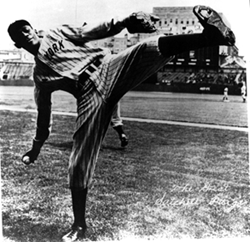![]()
The Rise of the Pittsburgh Crawfords,
1925-1933


As the Crawfords rose in talent and accomplishment, they won city recreation league pennants, and also started receiving more donations from the community. Gus Greenlee made his first key donation to the team in 1926; his donation provided the funds for new team uniforms.
The Crawfords gained a number of players from the Edgar Thomson Ball Club in 1928, including Harold Tinker, Charlie Hughes, and other recruits like Josh Gibson. Even though they lost some players to the Grays, the addition of the other recruits made the team the best sandlot team in western Pennsylvania.
1930 proved to be an important year for the Crawfords. The Crawfords and the Grays met for the first time at Forbes Field that season; the Crawfords lost, but earned more popularity throughout the community. Gus Greenlee also agreed to buy the team in 1930; he promised to pay each player a salary of $125 per month, but instituted a play or work policy. Each member of the team had to either quit his day job, or quit the team. Several players such as Tinker had to leave the team under this policy. As players left, Greenlee started to recruit heavily off the Hill for their replacements.

Satchel Paige
Toward the end of 1931, Greenlee made two vital decisions for the team:
he hired Satchel Paige, and started building
Greenlee Field. When the field opened
in 1932, it held over 7,000 fans, and soon became a landmark on the Hill.
After opening the field, Gus turned his attentions again to recruiting. In 1932 he acquired more big-name players.
Sam Streeter, Jimmie Crutchfield, Oscar Charleston, Judy Johnson, Josh Gibson, Ted Page, Jud Wilson, John Henry
Russell, Bill Perkins, and Ted Radcliffe all joined the Crawfords in 1932, and the team was again transformed.
It was no longer a city sandlot team, but a professional team that was based in the Hill.
As his team grew stronger, Gus turned his eyes toward another dream that would continue to professionalize--and
isolate--
the Crawfords team; he looked to resurrecting the Negro
National League, and looked forward to acting as its head commissioner.
Its rise in popularity and new ownership under Greenlee sent the Crawfords team spinning toward new heights by 1933. Greenlee's heavy recruiting and focus on winning set the stage for a whole new powerhouse of a team to form by 1935.